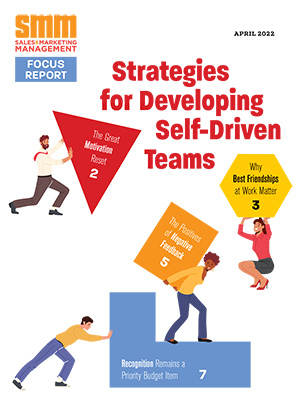Sad but true, the average life of a chief marketing officer is only about two years. That’s according to Spencer Stuart (a leading executive search consulting firm)—and it’s probably 18 months too long. The problem is that most marketing leaders are best suited for management, not leadership roles. So, what’s the difference? Let’s take a closer look.
Leadership by Airline Magazine
“What’s your Red Zone marketing strategy?” This was the first question an executive asked me during a breakfast interview several years ago. We were meeting at an airport hotel, and I assumed he had read about Red Zone marketing (the concept that uses an analogy to the football field where the last 20 yards represent the most critical area in the business—where companies win or lose, succeed or start over) in the United Airlines magazine en route from Silicon Valley.
While there is certainly nothing wrong with Red Zone marketing per se, what had me looking for the door while the orange juice was being poured was the fact that this guy was so buzzword compliant. He seemed less interested in discussing strategies for growing his business than reciting sound bites concerning the latest marketing fad. Perhaps he just never experienced how a true marketing leader could impact his business.
Resolve to Lead or Forever Bleed
Another memorable moment was meeting the director of marketing communications at a company I had just joined. As the new head of marketing, one of my first requests was to review her marketing plans and recommendations, along with her goals and budget. Instead, she handed me a nicely bound “advertising spending” study that had been prepared by an advertising agency. I was even more startled when she proudly declared, “This is what we need to do because our competition is doing it.” It was all downhill from there as she introduced six-figure branding proposals prepared by other consultants. She appeared uninterested in new ideas or growing her skills, but kept citing the length of time she had been with the company as a primary reason for earning her position.
However, all was not lost at my new company. The marketing department had talented people who were starving for leadership—ordinary professionals who, once empowered, could achieve extraordinary results. They were people with great attitudes and aptitudes, but they lacked a leader they could trust and follow. To make matters worse, fear was pervasive throughout the department. It reminded me of a global consulting firm where it was said success was worth 100 points, but failure was a punishing minus 1,000—leaving most people thrashing below the radar.
Leadership is neither magical nor charismatic, and it certainly isn’t a replacement for management. Rather, they are complementary systems. The typical business today is over-managed and under-led. In today’s economy, with so much importance placed on profitability to “ride out the storm,” one could argue that strong management is more essential than leadership. However, being able to capitalize on an economic downturn and emerge a more dominant industry leader (as IBM is doing) requires great leadership and vision. It’s also true that businesses that are paralyzed usually suffer from having too many managers and not enough leaders. That means C-level players may need to be replaced to facilitate change across the company.
It also can be argued that management is about dealing with complexity, while leadership is focused on change. Not everyone can handle both. Since change has become such a pervasive driver in our “smaller, smarter world,” greater demands are being placed on leaders to set direction, develop a vision and support strategies, and align a network of people and teams to get there.
Be a Change Agent
Since many marketing professionals grew up in the IBM world with the “Think” mantra, I launched a new initiative called “Think Different.” I also stressed the importance of developing systems that eliminate redundancy, enabling marketers to do more with less and focus on the more creative aspects of their jobs. As a result, they became more productive than they ever imagined, while expenses declined, most outsourcing was eliminated, and performance skyrocketed. In short, the combination of instilling a bullet-proof vision with systems to support it enabled ordinary people with good skills and attitudes to achieve great things.
Following an approach outlined by John P. Kotter of Harvard Business School (“What Leaders Really Do”), I moved the global marketing team through several important stages, successfully creating change across the organization and business as follows:
1.Created a sense of urgency: We got the word out that “business as usual” was no longer acceptable for the ongoing viability of the company.
2.Created a solid team:With all the emphasis on rock-star creativity in marketing, it’s important to remember that it takes a village and you’re only as strong as your weakest Webmaster or copywriter.
3.Created a shared vision: The team needed to know where it was going and how much better life would be—for them and the business—when they arrived.
4.Communicated the vision: Buy-in from key stakeholders across the business was vital.The CEO and heads of sales, R&D, and finance especially needed to be on board.
5.Empowered employees to act: They had to know they were not air traffic controllers—if they made a mistake, they were not likely to kill anyone. People needed to take educated risks, and it was up to the leaders to encourage and support them.
6.Produced short-term results: We launched a viral campaign that sent Web traffic off the charts, then publicized the success and gave full credit to those who contributed and took the risks.
7.Built momentum: From there, we transformed an expensive “traditional” marketing mix into an optimized balance of proven methods and new media strategies that leveraged the latest technologies.
8.Anchored behavior in organization culture:And we never stopped. The bar continually was set higher, people were empowered and recognized for their accomplishments, and the status quo was never tolerated.
Be a Visionary
Marketing executives who don’t lead are likely to fail, creating plans, checklists, and budgets rather than the visions and strategies needed to lead the business forward. Leadership is inherently more difficult than management because it is less formula-driven, while management is a more systematic enabler of a vibrant vision and strategy. Companies simply cannot compete in today’s compressed cycles without strong leadership.
Edward Vesely is senior vice president of World Wide Marketing at Vision Solutions (visionsolutions.com), a provider of high-availability and disaster recovery solutions for IBM Power Systems. He serves on several advisory boards and is the author of “Code to Commerce, High Technology Marketing for Maximum Brand Performance.” Vesely can be reached at veselyusa@gmail.com.
Do You Need to Fire Your Chief Marketing Officer?
Get our newsletter and digital focus reports

Stay current on learning and development trends, best practices, research, new products and technologies, case studies and much more.

